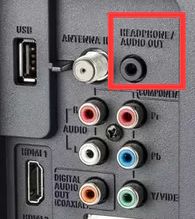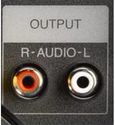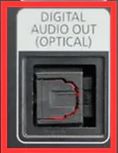TV Audio Outputs
This page covers the main ways to connect a TV Streamer to a TV without muting the TV speakers and there are a number of things to consider.
On a typical TV there are often connections down the side panel of the TV along with connections on the back panel of the TV.
Mostly it is better to use the connections on the back panel of the TV rather than the connections on the side.
Analogue Audio Output
 Typically you might see a 3.5mm headphone socket on the side of the TV, sometimes on the back panel. If you connect your TV Streamer to a headphone socket there is a medium to high chance that the speakers on the TV will be muted (not great for others in the room!). Sometimes you can adjust the settings of the TV to stop the speakers from muting. This type of connection is always analogue audio output.
Typically you might see a 3.5mm headphone socket on the side of the TV, sometimes on the back panel. If you connect your TV Streamer to a headphone socket there is a medium to high chance that the speakers on the TV will be muted (not great for others in the room!). Sometimes you can adjust the settings of the TV to stop the speakers from muting. This type of connection is always analogue audio output.
TIP – If you are stuggling to connect, try using the headphone socket for troubleshooting purposes first, even if it is not the long term solution it can be useful for working out where the issue is.
Remember you need to make sure your hearing aids are paired to the TV Streamer, and often you need the app on your phone to control the audio output from the TV and TV Streamer to your hearing aids too.
Your TV Streamer user booklet will typically tell you what indicator lights to look out for, how to ensure a successful pairing etc.
 A common analogue connection you might see on the back panel of an older TV is RCA or Phono – red and white sockets for left and right audio. This type of connection can either be audio INPUT or audio OUTPUT and is usually labelled either as one or the other.
A common analogue connection you might see on the back panel of an older TV is RCA or Phono – red and white sockets for left and right audio. This type of connection can either be audio INPUT or audio OUTPUT and is usually labelled either as one or the other.
Connecting to an audio input will NOT work, if you are using this type of connection with a TV Streamer, it MUST be to an audio output connection.
If connected to RCA analogue audio output the TV Streamer should be able to send audio to your hearing aids without muting the TV speakers.
Digital Audio Output
 HDMI is a very common audio and visual connection but generally does not connect to TV Streamers, you see this type of cable connection a lot with set top boxes etc.
HDMI is a very common audio and visual connection but generally does not connect to TV Streamers, you see this type of cable connection a lot with set top boxes etc.
 TOSLink (Optical Audio Output) is a very common connection for TV Streamers. If you have a TOSLink audio output on the back panel of your TV it is generally the best connection to use.
TOSLink (Optical Audio Output) is a very common connection for TV Streamers. If you have a TOSLink audio output on the back panel of your TV it is generally the best connection to use.
You may already be using that connection on your TV with a soundbar, if so you can use a splitter at relatively low cost to work with both devices, or connect your soundbar another way to make way for the TV Streamer using TOSLink.
Guidance on inserting a TOSLink cable connection into the back of your TV – watch this.
 Coaxial digital audio output is available to use with some TV Streamers and on some TVs but is not particularly common, however it can be an alternative to use sometimes.
Coaxial digital audio output is available to use with some TV Streamers and on some TVs but is not particularly common, however it can be an alternative to use sometimes.
The TV Streamer you buy may have some or all of the above cable connections to connect your TV to your TV Streamer.
TIP – Sometimes you just need to try everything with everything, including considering taking audio from a set top box if available and it is proving difficult to get audio streaming in other ways.
There is a lot of variation between TV models and audio setups. If it seems confusing and you need advice probably the best thing to do is send us a good picture of the back panel of your TV where all the audio outputs are, but make sure your image is sharp enough for us to be able to see the sockets and labels.
N.B. Before you send us such an image make sure to look at the image yourself first, if you can’t see the connections clearly and can’t read the labels, then we are likely to struggle with it too!
